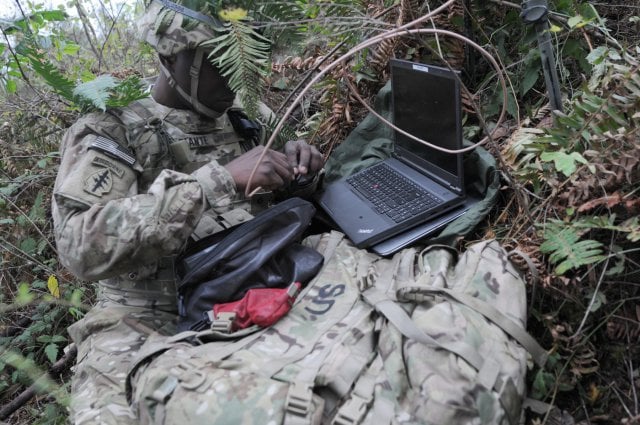
A soldier from the Army’s offensive cyber brigade during an exercise at Fort Lewis, Washington.
WASHINGTON: A hundred flowers are blooming in the Defense Department’s different AI victory gardens, but the Joint Artificial Intelligence Center worries they won’t be compatible.
That’s less a technology problem than an organizational and cultural one, JAIC officials said at AFCEA NOVA’s IC IT Day conference. The Joint AI Center is now working with the rest of the Defense Department to develop processes, policies, and governance for everything from AI ethics to data sharing – a top priority for the Pentagon.
“We’re talking about data as a strategic asset,” said JAIC’s acting deputy director, Jacqueline Tame. The need to share data freely is touted in every AI strategy document; longstanding security compartmentalization processes get in the way.
“There are several thousand security classification guidance documents just in the Department of Defense alone that basically ensure that people can say they own data,” Tame said. “That’s is antithetical to the idea that data is a strategic asset for the department.”
You can’t write code or train an algorithm to solve this kind of problem. You need to change hearts and minds. “People anticipate the answer to these questions is going to be technological,” Tame said. “It’s not. It’s really going to be about the education first [and] processes.”
That’s a shift for the JAIC which began with a big focus on developing cutting-edge AI in-house. It still does some such projects, but increasingly “the services and combatant commands are taking those on,” Tame said. “In fact they’ve matured quite a bit… at key places like Army Futures Command and SOCOM and in the Air Force.”
“But…what’s still not happening is the connective tissue between all those capabilities,” Tame said. “We need to be interoperable in order to achieve the goals we’re trying to achieve here.
“Ensuring this interoperability, this connective tissue [is] one of the things that we’re really trying to push – especially on the JADC2 front,” she added. “Gen. Crall, the Joint Staff J-6, has been absolutely a phenomenal partner.”
Nowhere is interoperability among different organizations more crucial than in JADC2: Joint All-Domain Command & Control. That’s the ambitious effort to share targeting data, tactical intelligence, orders, and plans among all the services – and US allies – across land, sea, air, space, and cyberspace. That’s a tremendous technical problem, But commanders can’t just delegate JADC2 development to their communications officers or their IT department, as JAIC director Lt. Gen. Michael Groen told us in a recent interview. It’s too crucial to how the future force will fight.
Getting that point across has been an uphill battle, Tame said. “When we talk about concepts like JADC2, the initial gut reaction, in our experience, has been to think about this as a comms issue, as an IT issue,” she said. “[We’re] continuing to repeat the mantra that, ‘no, this is a warfighting issue.’
“This is not a panacea, and that’s a hard thing for a lot of people to swallow. You can’t just sprinkle AI on all these legacy systems and expect them to work and talk together,” she said, especially when an adversary is actively trying to hack or jam your communications. “That’s not how it works. There’s a mental model shift that has to happen across the department. The first step [is] not particularly sexy….The first step is helping to educate the department and our partners and all of our stakeholders.”
This education-first approach is part of what’s called “JAIC 2.0,” an evolution of the AI Center from its original focus on building its own AI to enabling other defense organizations to build them. Over the past two-and-a-half years, Tame said, “we’ve learned what the department actually needs is enabling services” most of all.
Under the JAIC 2.0 approach, the center plans to offer a set of technical tools, called the Joint Common Foundation, that will let defense organizations build their own AIso, JAIC will offer streamlined contracting mechanisms so defense organizations can hire companies to clean up their data and then test & evaluate their code.
That may sound basic. But, Tame said, “frankly, after two-and-a-half years of assessment of our department’s AI readiness, [we realized] these critical building blocks — that will enable us to get to the point of implementation of AI across the force in a really cohesive way — are not there yet.”
Major trends and takeaways from the Defense Department’s Unfunded Priority Lists
Mark Cancian and Chris Park of CSIS break down what is in this year’s unfunded priority lists and what they say about the state of the US military.


























